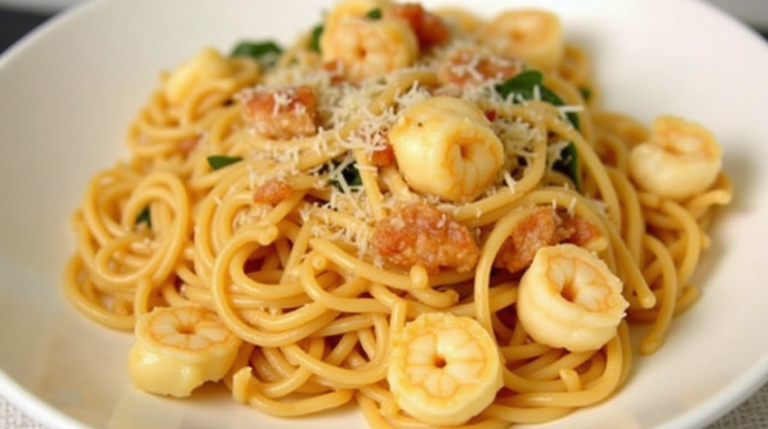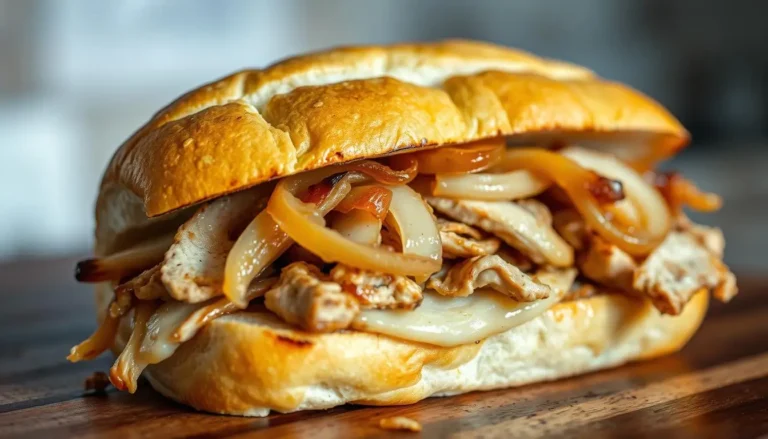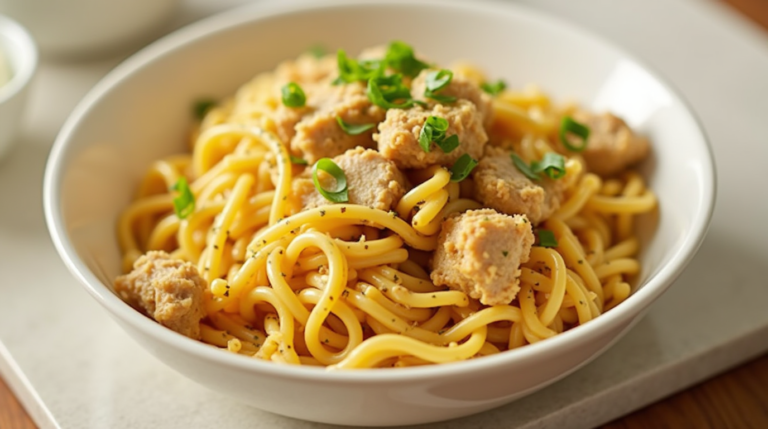Did you know over 60% of honey sold in U.S. stores is creamed honey? Yet, only about 15% of households know how to make it at home? This smooth, spreadable treat is not just a luxury. It’s something anyone can make in their kitchen.
Creamed honey, also known as whipped or set honey, turns runny honey into a velvety spread. It’s more than a pantry staple. It’s a versatile ingredient for toast, baking, or even savory dishes. This guide will show you the creamed honey recipe and the secrets of how to make creamed honey.
Table of Contents
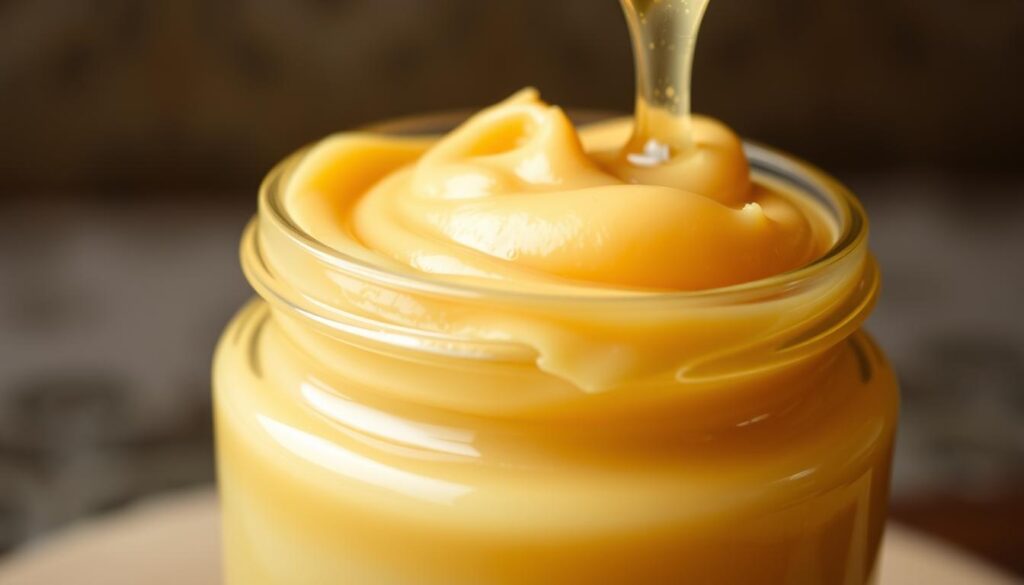
Key Takeaways
- Creaned honey stays spreadable year-round without crystallizing.
- Making it at home cuts costs by up to 40% compared to store-bought brands.
- Its texture comes from controlled crystallization, not additives.
- Works with any raw honey type, from clover to wildflower.
- Easier to use in baking than liquid honey due to consistency.
What Is Creamed Honey and Why Make It at Home?
Creamed honey is honey that’s been made smooth and spreadable. It’s different from store-bought honey because you can add your own flavors. Plus, you don’t have to worry about additives. This part will dive into the science and perks of making it yourself.
The Science Behind Crystallized Honey
Honey turns into crystals naturally because of glucose. To make creamed honey, we control this process. We use temperature and tiny honey crystals to get a smooth texture.
This way, we turn liquid honey into a creamy spread. But we don’t change its taste or nutrients.
Difference Between Raw, Regular, and Creamed Honey
- Raw honey: Unprocessed, unheated, and unfiltered, keeping pollen and particles.
- Regular honey: Often pasteurized and filtered to slow down crystallization.
- Creamed honey: Made by a special crystallization process for its spreadable form.
Benefits of Making Your Own Creamed Honey at Home
Making creamed honey at home gives you control over what goes into it. You can add spices like cinnamon or lavender for unique tastes. Unlike store-bought, homemade honey doesn’t have added sugars or preservatives.
It also lasts longer when stored properly. And, its creamy texture means no more sticky spills on your toast!
Essential Ingredients for the Perfect Creamed Honey Recipe
Making a smooth creamed honey recipe starts with the right ingredients. The easy creamed honey recipe needs high-quality parts for that velvety texture. Raw honey, seed honey, and optional flavorings are key. Each is crucial for success.
Selecting the Right Raw Honey
For the best results, pick raw, unprocessed honey. Pasteurized honey doesn’t have the natural crystals needed. Choose clover or wildflower honey for consistency. Here’s how different honeys compare:
| Honey Type | Flavor Profile | Best For |
|---|---|---|
| Clover | Mild, sweet | Classic creamed honey |
| Wildflower | Complex, floral | Rich textures |
| Orange Blossom | Citrus notes | Flavor-enhanced batches |
The Importance of a Quality Starter (Seed Honey)
Seed honey is a crystal catalyst. Choose honey that’s already started to crystallize smoothly. Use a 1:9 or 1:10 ratio of seed to liquid honey for even texture. Smooth, creamy seed honey is key for consistent results.
- Check for small, uniform crystals in seed honey
- Store extra seed honey in a cool place for future batches
Optional Flavor Additions
Customize your easy creamed honey recipe with natural additives. Vanilla, cinnamon, or citrus zest can be mixed in during blending. Add ½ teaspoon of spices or a few drops of essential oils per cup of honey. Avoid overmixing to prevent air bubbles.
- Vanilla extract for warmth
- Citrus zest for brightness
- Spices like cinnamon or ginger for depth
Equipment You’ll Need for Homemade Creamed Honey
Follow creamed honey instructions with confidence by gathering the right tools. Every piece of equipment plays a role in achieving that silky texture.
- Clean Glass Jars: Use sterilized containers for storage. Mason jars work well for small batches.
- Stainless Steel Bowl: Ideal for mixing to avoid temperature fluctuations.
- Food Thermometer: Monitor honey between 80–90°F to prevent overheating.
- Whisk or Spatula: Stainless steel tools ensure even mixing without metal contamination.
- Double Boiler: A heat-safe bowl over a pot of simmering water prevents scorching.
| Essential Tools | Optional Upgrades |
|---|---|
| Plastic or silicone spatula | Electric mixer (bread hook attachment) |
| Measuring cups | Temperature-controlled incubator |
| Labels for jars | Large mixing paddle for commercial batches |
For creamed honey tutorial success, avoid reactive metals like aluminum. A warming pad keeps batches stable during crystallization. Always sterilize jars in boiling water 10 minutes before use.
- Reuse clean yogurt containers for small test batches.
- Use a clean dish towel as a lid if jars lack lids.
Pro tip: Keep tools separate from acidic foods to avoid residue affecting honey’s flavor.
Step-by-Step Creamed Honey Process
To master the creamed honey process, follow these simple creamed honey steps. This method ensures smooth, consistent results every time.
Preparation Phase: Getting Your Honey Ready
Start by warming raw honey to 95–104°F (35–40°C). Use a candy thermometer to avoid overheating. Strain out crystals or debris with a fine mesh sieve. Prepare seed honey by selecting pre-creamed honey as your starter crystal base.
Mixing Method: Incorporating the Seed Honey
- Combine 90% warmed honey with 10% seed honey in a clean bowl.
- Use a spatula to fold gently until no visible seed honey streaks remain.
- Avoid over-stirring to prevent air bubbles that disrupt crystallization.
The Waiting Game: Crystallization Period
Transfer mixture to a sterilized jar. Store at 57°F (14°C) in a pantry or cellar. Check daily for visible texture changes. Full crystallization takes 3–14 days—patience ensures even grain formation.
Final Processing Steps
Once fully set, stir gently with a clean spoon to refine texture. Transfer to airtight containers. Store at room temperature for best consistency. Properly processed honey remains spreadable for months when stored correctly.
How to Make Creamed Honey Without a Starter
Creating homemade creamed honey doesn’t need a starter. Try these easy methods for smooth results.
Alternative Seeding Methods
Start crystallization with common items instead of seed honey:
- Naturally crystallized honey: Scrape crystals from old honey jars and blend into fresh honey.
- Powdered sugar (1 tsp per cup of honey): Dissolve thoroughly before mixing.
- Commercial crystallized honey: Even imperfect store-bought options work as substitutes.
Natural Crystallization Technique
Try this slow method for no-starter results:
- Store honey at 50-59°F (10-15°C) for 7 days.
- Shift to 40-45°F (4-7°C) for 14 days.
- Bring to room temperature; stir daily to monitor crystal formation.
| Method | Steps | Time |
|---|---|---|
| Alternative Seed | Blend crystals or additives | 1-3 days |
| Natural Crystallization | Temperature cycling | 3-4 weeks |
Be patient—natural methods take time. Check texture and temperature weekly. Adjust steps if crystals form unevenly.
Troubleshooting Your Creamed Honey at Home
Even with a precise creamed honey tutorial, unexpected issues can arise during your homemade batches. This section addresses common pitfalls and practical fixes to ensure success with your creamed honey at home.

Common Problems and Solutions
Separtion or air pockets? Let the mixture rest overnight in a cool spot. Overly bubbly? Strain through a mesh sieve. Fermentation? Use fresh, raw honey and store below 70°F. Always seal jars tightly to prevent contamination.
When Your Honey Won’t Cream Properly
If honey remains runny, check these factors:
- Overheating: Avoid temperatures above 120°F to preserve natural enzymes.
- Moisture content: Use honey with under 18.6% moisture (test with a refractometer).
- Inadequate starter: Ensure seed honey makes up 10-20% of the total batch.
Test small batches first to avoid waste.
Fixing Texture Issues
Grainy texture? Warm the batch gently to 95°F, remix with seed honey, and reprocess. Too hard? Microwave 10-second bursts until spreadable. Runny? Add more seed honey and refrigerate for 24 hours.
Patience is key—some fixes require 1-2 weeks for results. Adjust one variable at a time to track progress. Properly stored batches can last 6-12 months when sealed airtight. With these strategies, most batches can be salvaged even after setbacks.
Creative Ways to Customize Your Easy Creamed Honey Recipe
Turn your easy creamed honey recipe into a must-have in your kitchen. Add flavors like vanilla bean paste (1 tsp per cup of honey) or citrus zests. Lemon or orange zests are best when finely grated to avoid bitterness.
For a bold twist, mix in spices like ground cinnamon or cardamom. Or, try fresh herbs like lavender or thyme. Coffee or cocoa powder can add a surprising depth, pairing well with dark honey.
- Citrus Zest: Use organic lemon or orange zest with orange blossom honey for a vibrant kick.
- Spice Blends: Mix ½ tsp cinnamon or nutmeg into your creamed honey recipe for a cozy winter treat.
- Herbal Infusions: Steep dried lavender or rosemary in warm honey before the crystallization phase.
Play with textures too: blend honey until it’s super smooth or add a pinch of pre-crystallized honey for a grainy texture. For color, add beetroot powder for pink or turmeric for golden. Store jars with different flavors layered for a pretty look.
Try small batches first to see how they turn out. Note that some ingredients, like high-moisture fruits, might slow down crystallization. Label jars with flavor names and dates for gifts. Your creamed honey recipe is a blank canvas for your creativity. Let your curiosity lead your next kitchen adventure!
Storing Your Homemade Creamed Honey
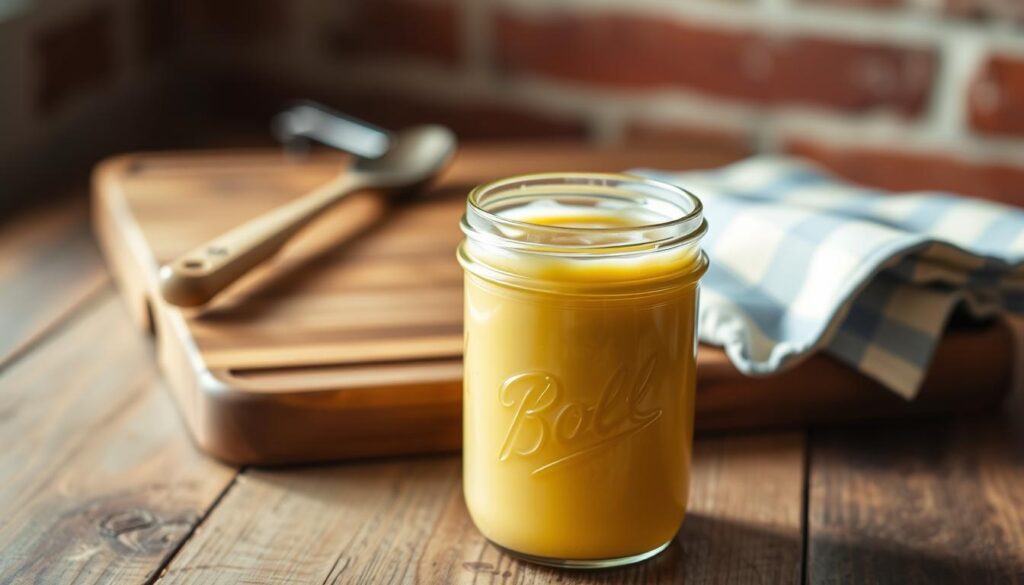
Keeping your homemade creamed honey fresh is key. Follow these tips to enjoy it for months. The right storage keeps it smooth and tasty.
Ideal Storage Conditions
Keep your creamed honey in a cool, dark spot like a pantry. Aim for temperatures between 50–70°F (10–21°C). This prevents it from separating or forming crystals.
Use glass jars with tight lids. Plastic can pick up smells. Don’t put it in the fridge, as temperature changes can mess up its texture.
- Container choice: Glass jars with airtight seals.
- Light exposure: Keep away from windows or direct sunlight.
- Moisture control: Ensure lids are fully sealed to block air.
Shelf Life Expectations
Homemade creamed honey stays good 6–12 months when stored right. Honey doesn’t spoil, but long storage can change its texture or taste. Date your jars and use the oldest first. Don’t keep open jars for more than a year.
- Mark containers with dates for easy tracking.
- Discard jars with visible mold or off-odors immediately.
Signs Your Creamed Honey Has Gone Bad
Watch out for these signs:
- Fermentation: Bubbles or a wine-like smell mean yeast is active. Toss it if you see this.
- Pooling liquid: Too much moisture on top can cause bad growth.
- Grainy texture: If it’s too grainy, it’s not stored right, but it’s not harmful.
Always check for strange smells or texture changes. If unsure, it’s best to throw it away for safety.
Delicious Ways to Enjoy Your Creamed Honey
Once your creamed honey is ready, it’s more than just for toast. It adds a smooth touch and a rich taste to any meal. Here are some creative ways to use it:
Breakfast Applications
Begin your day with creamed honey’s silky feel. It’s perfect for mixing into yogurt or swirling into overnight oats. Try these breakfast ideas:
- Honey butter: Blend with softened butter for flaky biscuit toppings
- Pancake glaze: Combine with vanilla extract and warm milk
- Granola cups: Layer with Greek yogurt and fresh berries
Baking with Creamed Honey
Use it in your favorite creamed honey recipe for a sweet touch. Replace 1 cup of liquid honey with 3/4 cup of creamed honey in:
- Sandwich cookies: Pipe into layers of vanilla wafers
- Cinnamon rolls: Fold into dough or use as a filling
- Muffins: Mix into batter for even moisture distribution
Savory Pairings
Try unexpected pairings with creamed honey. Its smooth texture is great for:
- Glazes: Brush on roasted Brussels sprouts or pork chops
- Marinades: Blend with soy sauce and ginger for chicken
- Cheese boards: Pair with sharp cheddar or blue cheeses
It’s also perfect for drizzling over salads or mixing into vinaigrettes without clumping.
Health Benefits of Consuming Creamed Honey
When made right, creamed honey steps keep all the good stuff from raw honey. Unlike refined sugars, it has antioxidants and enzymes that boost health. Here’s how it helps you:
- Antibacterial properties: Honey’s natural acidity and hydrogen peroxide fight off bad bacteria.
- Antioxidant boost: Darker honeys like buckwheat have more disease-fighting compounds.
- Gut-friendly prebiotics: Its natural sugars feed good gut bacteria.
- Allergy relief: Local creamed honey at home made with pollen-rich honey may lessen allergy symptoms.
Honey’s glycemic index varies by type, often lower than refined sugar. It has minerals like zinc and potassium, unlike processed sugars. But, it’s important to eat it in moderation—experts say no more than 6–9 teaspoons a day.
“The crystallization process doesn’t change honey’s nutritional profile,” says the National Honey Board. “Properly made creamed honey keeps its natural goodness.”
While creamed honey steps make it smooth, it has the same health benefits as liquid honey. Its thicker texture might help you eat it slower, enjoying sweetness without too much. Always pick recipes that don’t heat the honey to keep its enzymes, like the starter method mentioned before.
Conclusion: Mastering the Art of Homemade Creamed Honey
This creamed honey tutorial shows how easy it is to make your own spread. You start with seed honey and learn to control the temperature. It’s a simple way to turn raw honey into a smooth treat.
Being patient and precise is key. Begin with a basic recipe and then try flavors like lavender or ginger. Each batch you make gets better, showing how small changes can make a big difference.
By making your own creamed honey, you avoid additives and control the sweetness. It lasts a long time and is great for gifts or special treats. This craft connects you to a long tradition of food making, with a modern twist.
Share your progress on social media or in online forums. Every batch you make helps you get better. Start your journey to making delicious homemade honey today.
FAQ
What is creamed honey?
Creamed honey, also known as whipped honey or spun honey, is honey that has been crystallized carefully. This makes it smooth and spreadable. It’s easy to use and tastes great.
How long does it take to make creamed honey at home?
Making creamed honey at home takes about 3 to 14 days. The quick mixing part is fast. But, waiting for the honey to become creamy takes time.
Can I make creamed honey without a starter?
Yes, you can make creamed honey without a starter. You can use other seeding methods or let it crystallize naturally. But, these methods might take longer and need careful temperature control.
What type of honey is best for making creamed honey?
Use high-quality raw honey for the best creamed honey. Clover, wildflower, or orange blossom honey can add great flavor. Unpasteurized honey also helps with crystallization.
How do I fix my creamed honey if it turns out too grainy?
If your creamed honey is grainy, try heating it gently to 95°F (35°C) and mix well. Adding a bit more seed honey can also help make it smooth.
What are some creative flavor additions for creamed honey?
You can add natural flavors like vanilla, cinnamon, citrus zest, or lavender to your creamed honey. Just make sure to use the right amounts so they don’t mess up the crystallization.
How should I store my homemade creamed honey?
Keep your creamed honey in a cool, dark place at 50-70°F (10-21°C). Use glass containers with tight lids to keep it fresh and prevent moisture.
What is the shelf life of homemade creamed honey?
Homemade creamed honey can last 6-12 months if stored right. It doesn’t really expire, but its texture and taste might change over time. It’s best to use it within a year for the best quality.
Are there any health benefits to consuming creamed honey?
Yes, creamed honey keeps all the good stuff from raw honey, like antioxidants and enzymes. It can help fight bacteria and might even help with allergies.
What’s the best way to enjoy creamed honey?
Creamed honey is great for many things. You can spread it on toast, use it in baking, or even in salad dressings. Its smooth texture makes it easy to use in many recipes.


